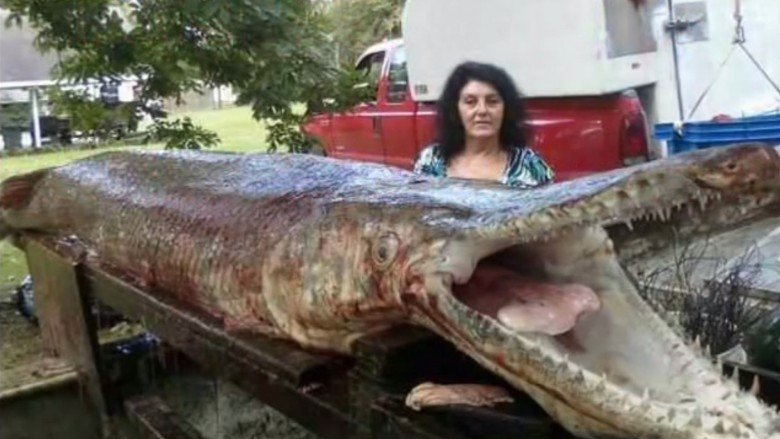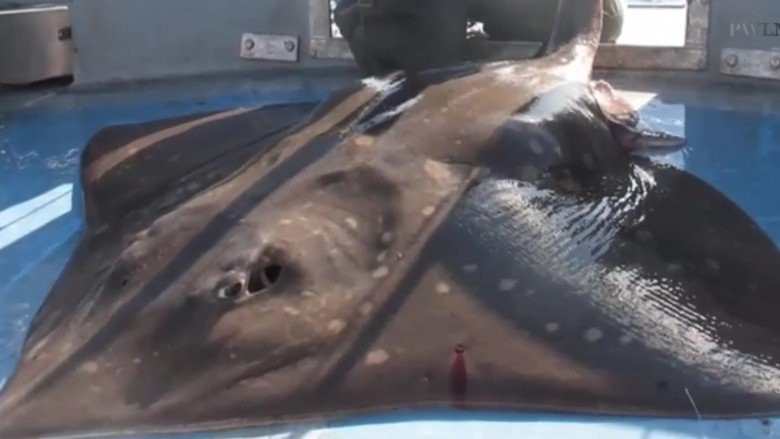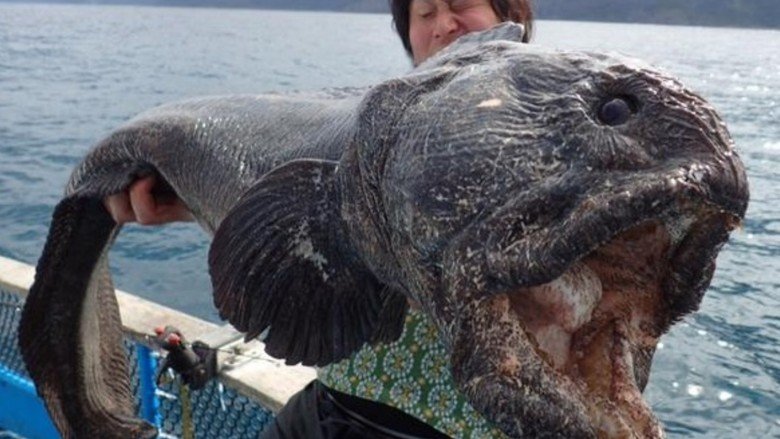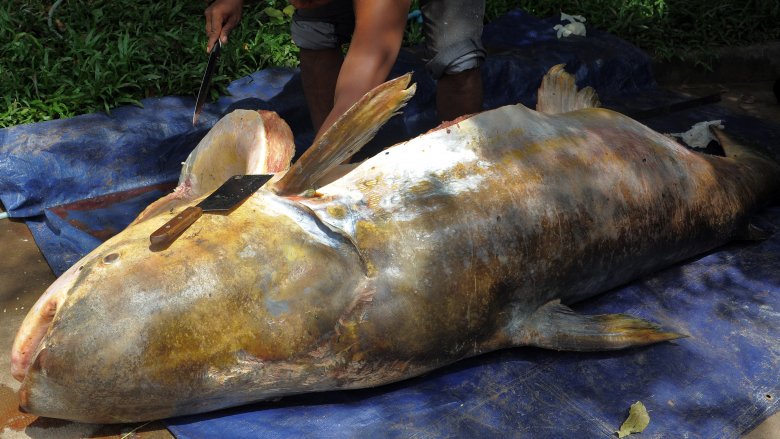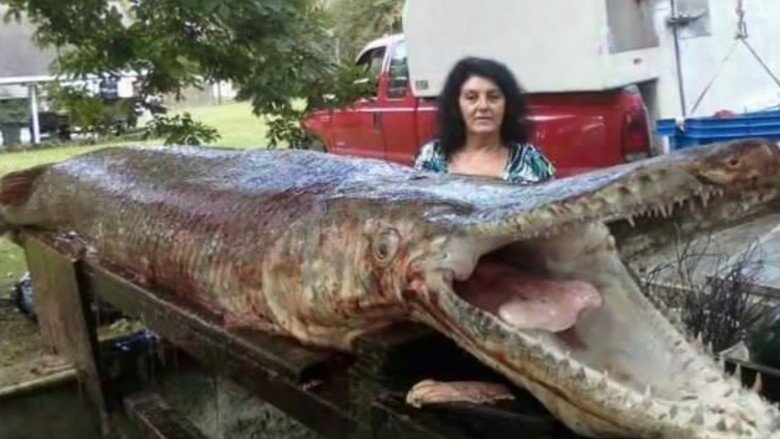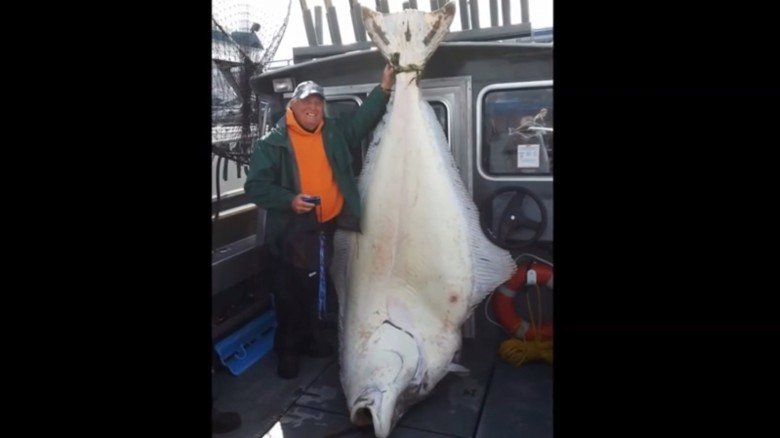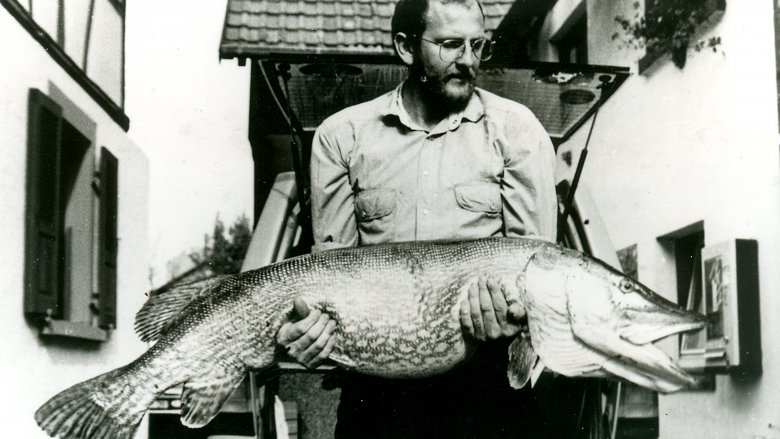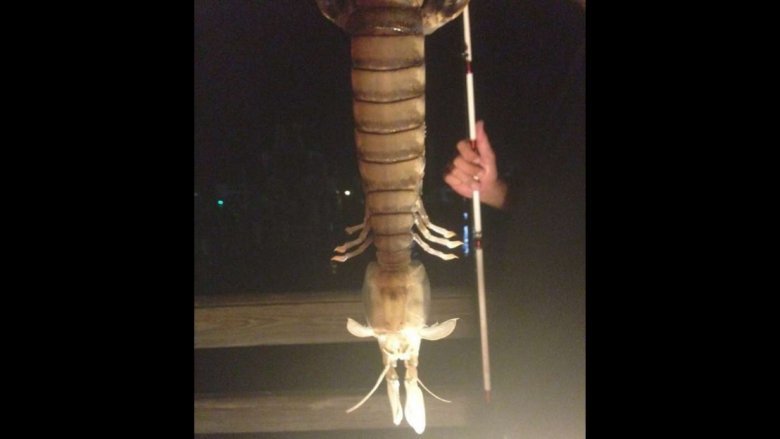Freaky Huge Fish That Were Actually Caught
Grab yourself a worm and tie it to a line. Toss it out into the river, and you just might be shocked at what you reel in. If you find a cartoonishly gargantuan mutant fish like the following ones, you might be too scared to even think about eating it.
The enormous ray
Remember petting cute sting rays at the aquarium? Imagine what would happen if that fish got its way into the same sewer that turned the Teenage Mutant Ninja Turtles into, well, them, only with a dash of the Psychomagnotheric goo from Ghostbusters 2. This mutant skate (freshwater rays with dorsal fins) might not "feed on bad vibes," but she's been feeding on its prey off the coast of Scotland for an estimated 55-65 years. Maybe that's why she looks like she's smiling.
Fisherman Andrew Logan reeled in all 222 pounds of her, using an entire dogfish for bait. Similar skatemonsters have been caught off the coast of Britain—like the 208-pounder one caught by Daniel Bennet that took two hours to reel in.
The gigantic wolffish
This terrifying beast is called a wolffish, despite it resembling neither a wolf nor a fish. Perhaps it was the attitude of the Big Bad Wolf that they were going for—gut it, and maybe they'd find Little Red Riding Hood.
When this hulk (nearly twice the size of the average wolffish) was captured, people were quick to assume it was the oceanic byproduct of nuclear radiation from the 2011 disaster at Fukushima. But experts who study nuclear effects on wildlife mostly agree this beast is likely not mutated by radiation, because generally nuclear mutations stunt growth cells and cause major shrinkage. As you can plainly see, this wolffish is quite large in size.
So yep, this beast was probably just born that way, no nuclear byproducts necessary. It got that big from nature, which is infinitely more terrifying. That means there might be more out there. Happy swimming!
Catfish-zilla
Of all the fish in all the freshwater lakes, this giant catfish could probably fit most of them inside its enormous body. And we're not talking the type that Nev and Max reel in on MTV that are manipulating dozens of vulnerable victims on the internet.
This 9-foot-long Catzilla was captured off the coast of Thailand and weighed in at an astonishing 646 pounds. That's heavier than your average motorcycle and most sumo wrestlers. The fish as large as a grizzly bear is classified as the endangered Mekong giant catfish. Despite its endangered status, anglers are allowed to harvest their eggs and return them to the water. This one, like most, did not survive the harvesting, so it was eaten. Endangered or no, this giant fish could supply more than double the average American's annual meat consumption. That's a lot of fish sticks.
The real-life Jurassic World sea monster
The alligator gar is a lot like the giant vore shark from Jurassic World, but unlike whatever that thing was, the alligator gar is completely real. Also, it's a fish—don't let it lie to you with that whole "alligator" malarkey.
This humongous gar, captured in South Texas by bow-fisherman Ben Crawford with a homemade bow, tipped the scales at an estimated 400 pounds and measured over 8 feet in length. A normal gar might hit 6 feet and weigh about 100 pounds, so this one's been eatin'. This particular beast did break the scale being used to weigh it, so its real weight is unknown, besides "a lot."
This freak of nature isn't alone either. A similar gar was captured in Mississippi, and expert fishermen agree there are plenty more of them out there, too. Just one more reason to swim in the hotel pool and that's it.
The dinosaur of a sturgeon
The Fraser River, located in British Columbia, Canada, is a hotbed for giant sturgeon, who are basically dinosaurs. Four anglers in two years successfully reeled in these giants, but in 2014, this 881-pound monster (versus the usual 100-pound guppy form this species typically comes in) was caught by Paul and Don Jarvis. The 19-year-old and his father were on the first day of Paul's first fishing trip. This sturgeon was the largest ever caught.
This hefty beast weighing in almost half a ton measured 11 feet 4 inches long. That's the same height as Hercules the liger standing on his back legs, or about the length of a small compact car. But what happens next with this lucky angler duo? The son will ask, "Daddy can we go fishing for giant sea monsters again?" to which father will reply, "Sure son." The two will fish for 72 hours straight to only catch a fresh sunburn.
In 2016, another giant sturgeon was caught in the Fraser River, but this time, it was the mythical "Pig-Nose," aptly named for his nose that was chopped flat on one of his unluckier days. Decades after Pig-Nose's first sighting, the River Monster Adventures company, led by self-proclaimed sturgeon whisperer Nick McCabe, reeled him in. The 650-pound, 10-foot-long fish was reeled in and then released shortly after to continue to amaze anglers and terrify unsuspecting swimmers.
The halibut they had to shoot
Halibut is a relatively common fish that you can find anywhere from your local fish market to the high seas. It's rare for this fish to grow over 3 feet, but exceptions are certainly out there.
While vacationing in Alaska in July 2014, California native Jack McGuire spent 40 minutes at Glacier Bay struggling to reel in what would turn out to be a 459 pounds of delicious halibut. The fish measured 95 inches long, but formally did not beat the previous record for largest halibut ever caught—due to Game Fish Regulations that restrict fish that have been harpooned from setting records. While McGuire and his crew were struggling to reel in this monster, all 459 pounds of it flopping around their boat posed a major threat to him and his crew, so they had no choice but to shoot it for their own safety, disqualifying it. They had one shot at fame but respectfully chose survival.
The huge goldfish that's 100 normal goldfish in one
The average goldfish is about 4 inches long and weighs approximately nothing. There's a good reason kids bring them home in small plastic bags. But some goldfish have no intent of staying that small, instead ballooning to ridiculous sizes that simply shouldn't be natural.
According to the New York Daily News, January 2013, fisherman Mike Martin was looking for perch when instead, he netted a 3-pound, 15-inch goldfish-o-saurus. These stats might not sound like much, but imagine a wasp the size of your palm. Now scream forever.
Mike's catch isn't the only mutant goldfish out there — people who dump unwanted aquarium fishies into the river might be surprised to learn their ex-pets can grow, quite quickly, into humongous, invasive water beasts. Australia's Vasse River is full of extra-large goldfish (coming in as heavy as 4 pounds) because they eat just about anything they can. This starves the local, smaller fish, while also spreading foreign diseases and destroying the environment around them. It's OK, though, because you no longer have to clean a small tank.
The biggest Chinook salmon ever caught
You probably know Chinook salmon as king salmon — as expected from a name like that, they're fairly big on a normal day. The average salmon can reach up to 3 feet and weigh around 30 pounds, but what Les Anderson caught in 1985 wasn't anything close to average.
On May 17 of that year, Anderson was out fishing for Chinook salmon when he got the equivalent of three big ones, wrapped in one incredibly strong package. He fought this 97-pound, 4-ounce beast tooth and nail — once subdued, he immediately rushed to weigh it before it dried out and lost precious water weight. Good thing he did; as of this writing, Anderson still holds the world record for king salmon. Oh, did we mention Anderson was 68 at the time? Because he was. Nearly 70 and he caught himself almost 100 pounds of fish. Think about that the next time you're 68 and trying to climb three flights of stairs.
Lothar Louis's monster pike
Northern pikes are a fairly gangly fish — the average pike can reach a couple feet long, but most weigh only a few pounds. Then there's the monster that the awesomely named Lothar Lewis bagged in 1986: it was more "tiny whale" than mere pike.
According to news reports, Lewis was planning to fish for carp on October 16, 1986, when he found a mega-pike instead. This thing clocked in at a record-setting 55 pounds and 1 ounce. It was so huge, Lewis couldn't actually net it, opting instead to grab by the insides of its gill covers and lift it out of the water. If you aren't familiar with pike, this can be dangerous. Their gill rakers and teeth are very sharp, so grabbing at them is a risky prospect. But as Lewis put it in a subsequent interview, he "was so excited, he did not feel the pain." If you think fishing is boring, you just haven't caught the right monster yet.
A lobster as big as your torso
Yes, we're aware lobsters aren't fish. But this giant lobster is awesome, and you're already here, so why not read on? Besides, would you complain if somebody served you this delicious monstrosity hot, fresh, and drenched in butter? Would you reject this dinner from heaven because it's not a fish? Of course not.
Most lobsters weigh a pound or two, though large jumbos can be up to 10 pounds. But the 23-pound lobster caught in New Brunswick, Canada, crushes them all. Yep, 23 pounds of boiled sea bug. You're gonna need a bigger bib.
This lobster, caught in November 2016 during the first day of crustacean season, is roughly 100 years old and ate plenty during that century. The Alma Lobster Shop, which gave the lobster a home, eventually sold the lobster to a good Samaritan. A local woman bought the massive lobster's freedom for $230 and asked the shop to simply return the lobster to the ocean. "King Louie," as he was nicknamed, hasn't surfaced since.
A gigantic 'shrimp'
The average shrimp is, you know ... pretty small. Just downright shrimpy. But one shrimp caught in Florida in September 2014 would need to be eaten from a trough.
The shrimp measured a should-be-illegal 18 inches long, roughly as long as the arm of the fisherman who caught it. That in itself is scary enough, but it gets worse. Officials at Florida Fish and Wildlife concluded it was probably a mantis shrimp. Confusingly, mantis shrimp are not actually shrimp. Rather, they're violent crustaceans known to swing their hammer claws at speeds approaching 50 mph. They do this to break through the shells of their prey, but they can also break aquarium glass. A typical mantis might reach anywhere from 2 to 7 inches, so at 18 inches, this one is squarely in nightmare territory.
